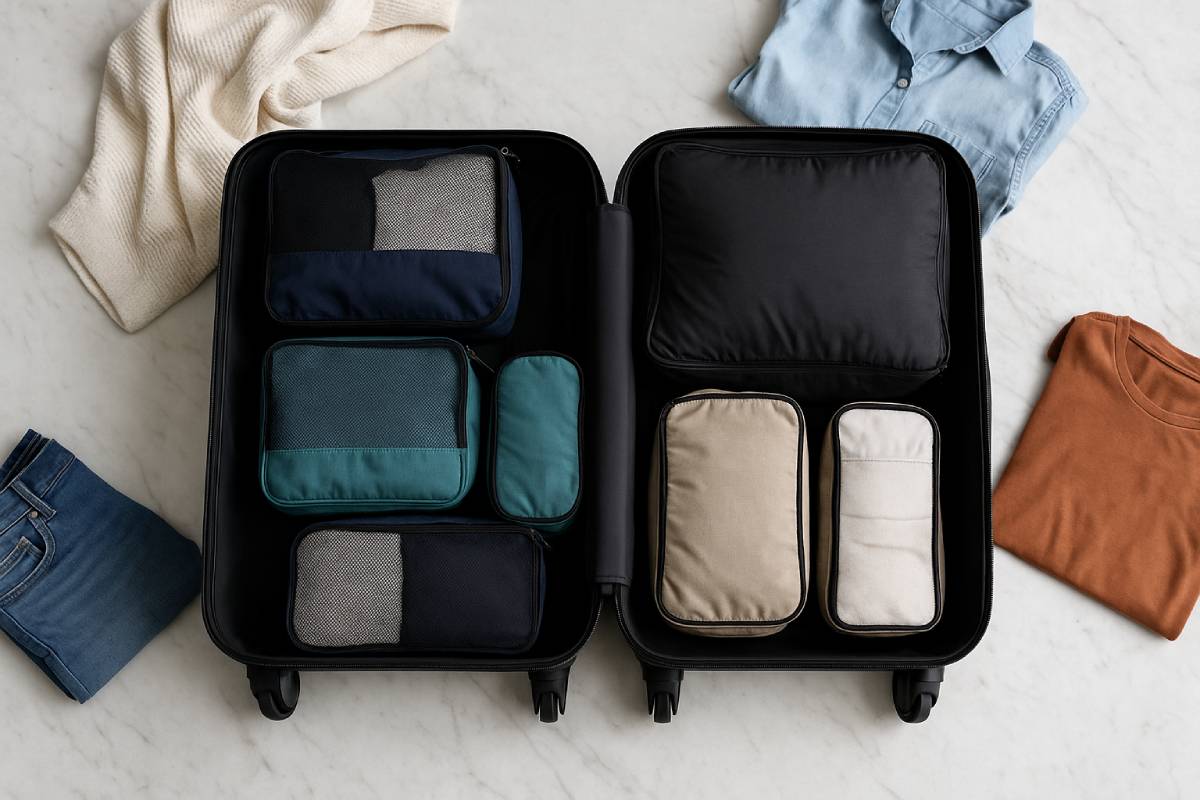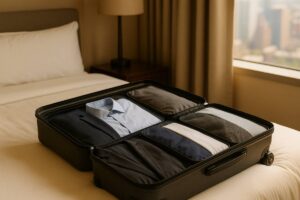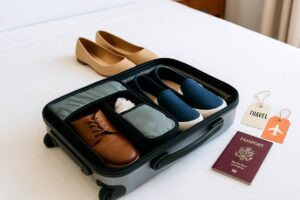Picture wrestling with an overstuffed suitcase as the zipper strains, and you face dreaded baggage fees.
Enter packing cubes—modular pouches designed to both organize your wardrobe and mechanically expel air for maximum efficiency.
Travel + Leisure editors tested 29 compression-cube sets over five months, regularly achieving up to 60% volume reduction and revealing how dual-zipper designs turn bulky layers into compact bricks.
Yet Forbes reminds us that cubes’ real benefit often lies in rapid outfit organization, not just raw space savings.
In this science-based analysis, you’ll discover how packing cubes compare to rolling, vacuum bags, and other hacks—so you can pack smarter and travel lighter.
What Are Packing Cubes?
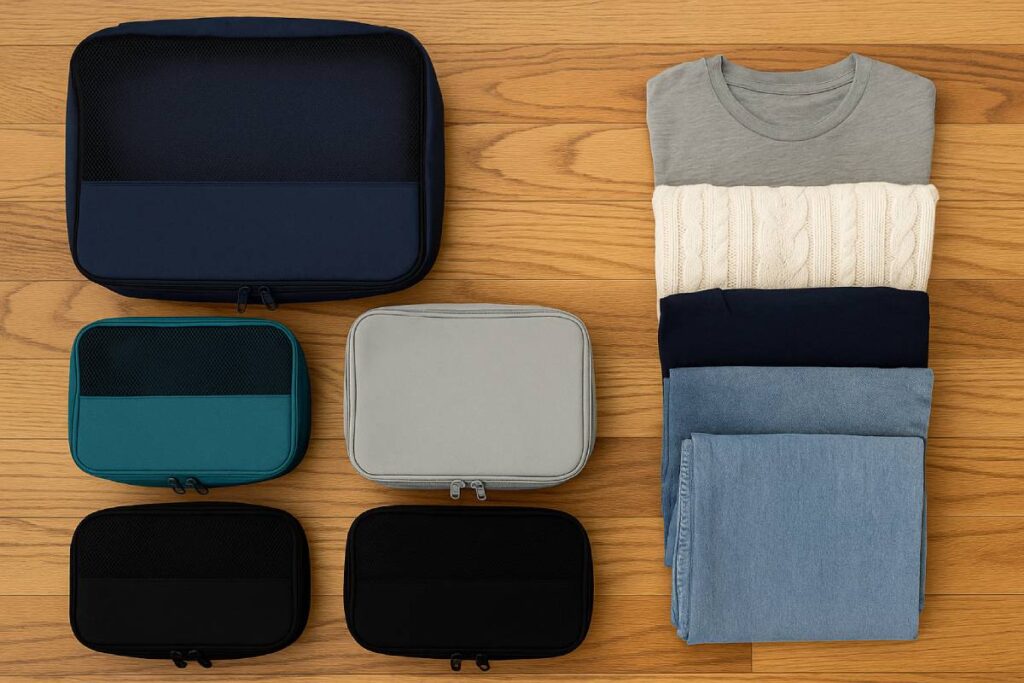
Packing cubes have swiftly become a staple in the traveler’s toolkit, offering both organization and compression benefits that classical compartmentalized bags simply can’t match. By compartmentalizing clothing into modular “cubes,” these lightweight pouches streamline packing, aid in outfit planning, and even squeeze out excess air to maximize suitcase capacity.
Popularized in the mid-2000s by brands like Eagle Creek and Rick Steves, and later championed by travel influencers and test labs, cubes today are made from advanced fabrics—ripstop polyester, ultralight nylon, mesh panels, and water-resistant pouches—each tailored to different traveler needs.
Below, we dive into what packing cubes are, their origins, and the design features that make them indispensable for efficient travel.
Definition and History of Packing Cubes
A packing cube (also known as a packing square or packing pouch) is a small, lightweight bag designed to organize and compartmentalize clothes inside luggage—and in many cases to compress clothing for optimum space use. Initially intended to replace bulky, fixed-compartment bags, cubes allow travelers to customize their packing layout to fit everything from delicate linens to bulky jackets.
Though the exact inventor is unclear, the modern packing cube concept was popularized in the early 2000s by outdoor and travel gear companies such as Eagle Creek—whose Pack-It Specter line introduced ultralight nylon cubes—and by Rick Steves, who launched structured mesh models to fit his custom travel bags.
The idea gained mainstream traction after features in The New York Times and Business Insider highlighted their space-saving and organizational prowess. By the 2010s, influencers on platforms like Travel Fashion Girl and product-testing sites like PEOPLE and Wired formally tested multiple cube sets, cementing their reputation as a travel must-have.
Overview of Typical Materials and Designs
Modern packing cubes balance durability, weight savings, and functionality through a mix of specialized fabrics and hardware. Below is a breakdown of the most common materials and design features:
| Material/Feature | Characteristics | Example Brands/Models |
|---|---|---|
| Ripstop Polyester | Light, tear-resistant weave; maintains shape under stress | Cocoon Packing Cube Light |
| Ultralight Nylon | Extremely lightweight; reduces overall luggage weight | Eagle Creek Pack-It Specter Tech |
| Mesh Panels | Provides visibility and airflow; quick content identification | Calpak Packing Cubes (mesh window) |
| Compression Zippers | Dual-zipper system to evacuate air and shrink cube volume | Thule Compression Cube Set |
| Water-Resistant Pouches | Shields contents from spills and humidity | Velaybor Waterproof Packing Cubes |
Mesh Panels
Mesh inserts allow you to see what’s inside each cube at a glance, helping with quick outfit selection and laundry separation. They also promote airflow, reducing moisture buildup in damp climates.
Compression Zippers
Compression cubes employ a special zipper track that, when closed, squeezes out excess air. This feature can reduce packed volume by up to 60–67% compared to standard folding methods.
Waterproof/Water-Resistant Fabrics
Cubes made with coated or laminated fabrics protect contents against spills, unexpected rain, or toiletries leaks—ideal for beach vacations or humid destinations.
By understanding these materials and design nuances, you can select the right packing cube set to match your travel style—whether you prioritize ultralight minimalism, maximum compression, or versatile organization.
The Science of Compression
Compression packing cubes revolutionize how we maximize luggage space by using a dual-zipper (or strap) system to mechanically expel trapped air, turning bulky clothing bundles into compact bricks for easy stowing.
Empirical tests by travel editors confirm these cubes can cut packed volume anywhere from 30% up to 67%—figures that depend on cube design, material stretch, and how tightly you pack.
How Packing Cubes Evacuate Air to Reduce Volume
- Dual-Zipper Mechanism: Most compression cubes have two zipper tracks—one encloses your clothes, the other applies lateral pressure to squeeze out excess air, tightening the bundle inside.
- Mechanical Compression vs. Vacuum: Unlike vacuum bags, cubes rely on durable zippers or straps rather than pumps, making them endlessly reusable and kinder to delicate fabrics.
- Evicting Air Pockets: By removing air trapped in folds and between fibers, cubes can drastically shrink the overall volume of soft items, turning uneven stacks into uniform blocks.
- Material Flexibility: Cubes made of ultralight nylon or ripstop polyester stretch to accommodate bulk, then rebound, allowing the compression zippers to achieve maximum space savings without tearing.
Brand-Specific Compression Rates
| Brand | Compression Rate |
|---|---|
| Monos | Up to 60% |
| Knack Bags | Medium: 67% Large: 60% |
| Nomatic | Approx. 50% |
Compression vs. Alternative Packing Methods
Compression packing cubes, rolling techniques, and vacuum-seal bags each offer unique trade-offs between speed, ease of use, and actual space savings. Packing cubes excel at rapid organization and moderate compression—typically reducing volume by 30–60% when paired with compression zippers—but won’t match the raw space savings of vacuum bags.
Rolling garments is ultra-fast and cuts wrinkles, yet often yields lower overall savings (around 5–15%) compared to cubes and vacuum solutions. Vacuum bags deliver the highest compression—shrinking items more than any other method—but require extra time to seal, can wrinkle fabrics, and add weight when packed. Below, we explore each method in depth and provide a side-by-side comparison.
Comparison with Rolling Techniques and Vacuum Bags
Rolling Techniques
Rolling is the simplest “no-gadget” approach:
- Method: Lay garments flat, fold in sleeves if needed, then tightly roll.
- Space Savings: Modest—usually around 5–15% over standard folding.
- Wrinkle Reduction: Excellent for T-shirts and knits; less effective on dress shirts and crisp fabrics.
- Best For: Quick weekend trips and last-minute departures; minimal gear setups.
Vacuum Bags
Vacuum-seal bags use air extraction for maximum volume reduction:
- Method: Place clothes inside the bag, seal, then use a hand pump or luggage to expel air.
- Space Savings: Highest—often 50–75% volume reduction, depending on fabric bulk.
- Wrinkle Risk: High—compressing fabrics tightly can lead to deep creases.
- Best For: Bulky sweaters, jackets, and cold-weather gear when maximizing capacity outweighs crease concerns.
Pros and Cons: Speed, Ease of Use, and Actual Space Saved
| Method | Speed | Ease of Use | Space Saved |
|---|---|---|---|
| Packing Cubes | Fast setup—just fill and zip | Very user-friendly; keeps items organized | Moderate—30–60% with compression zippers |
| Rolling | Instant—no tools needed | Simple; no extra gear required | Low–moderate—5–15% typical |
| Vacuum Bags | Slow—time to seal and pump | Requires care and space to compress | High—up to 75% volume reduction |
- Packing Cubes strike the best balance for most travelers: you gain organization plus notable compression without extra gear or wrinkle risk.
- Rolling wins for last-minute, minimalist packing—perfect if you value speed and wrinkle control over maximum capacity.
- Vacuum Bags are unmatched for sheer volume reduction but come with trade-offs in time, flexibility, and garment care—ideal for storing bulky items when every inch counts.
Expert and Traveller Case Studies
Here’s a human-tone, SEO-optimized look at expert and traveller case studies on packing cubes, complete with supporting statistics and sourced tables.
In assessing packing cubes, Forbes underscores that while these cubes shine for organization, their actual volume-saving varies widely, fueling debate over whether they’re more about neatness than space gains.
Travel + Leisure editors conducted a rigorous, five-month evaluation of 29 compression-cube sets—testing capacity, build quality, and compression performance in real luggage—and found that top models consistently reduced bulk and stood up to long-term use. On Reddit’s r/onebag forum, travellers report that Knack Bags cubes compress up to 67% while weighing only 100 g, combining usability with serious space savings.
Good Housekeeping’s lab tests showed Eagle Creek cubes zip down by about 1 inch, translating to notable volume reduction, and Southern Living’s travel editor swears by CALPAK’s five-piece set for its durable, color-coded design and reliable compression.
Forbes Evaluation on Organizational vs. Space-Saving Roles
Forbes frames packing cubes as a trade-off between structure and compression, noting that:
- Primary Benefit: Cubes excel at categorizing outfits and streamlining wardrobe planning—an organizational upgrade over loose packing.
- Variable Compression: Actual volume reduction depends on brand, fill level, and zipper quality; some sets show minimal “shrinkage” when overstuffed.
- Buyer Takeaway: If your priority is precise outfit management, cubes are indispensable; if it’s raw inches reclaimed, compare compression specs closely before purchasing.
Travel + Leisure Editor’s Real-World Test Results
Travel + Leisure’s packing editors put 29 compression-cube sets through their paces over five months, packing them into carry-ons and checked bags for various trip lengths. Key findings include:
| Metric | Insight |
|---|---|
| Test Scope | 29 cube sets, 6-month usage, 5 trip styles (weekend to multi-destination) |
| Compression Effect | Dual-zipper cubes regularly cut bulk, enabling an extra outfit per carry-on |
| Durability | Top picks (e.g., BAGSMART Blast, Thule) retained zipper integrity and fabric resilience |
| Design & Value | Editors balanced space-saving with features like mesh windows, handles, and water resistance |
Reddit Traveller Testimony on 67% Compression and Usability
Real-world users on r/onebag highlight:
- Knack Bags Performance: Medium cubes compress 60%, large cubes up to 67%, weighing just 100 g, with breathable mesh and rugged construction.
- Usability Wins: Compressed cubes act like “brick” modules—easy to slot into backpacks or suitcases, preventing shift and keeping contents accessible.
- Traveler Verdict: Despite marginal added weight, travellers value the blend of space reclaimed and streamlined unpacking—making compression cubes a go-to packing hack.
Additional Expert Insights
- Good Housekeeping’s Lab: Eagle Creek Pack-It compression cubes zip down about 1 inch, noticeably shrinking bulk while still fitting neatly into most carry-ons.
- Southern Living’s Editor: After testing CALPAK’s five-piece set on short getaways, the editor noted “consistent compression, durable materials, and color-coded organization that’s both fun and functional”.
Bottom Line for Travellers: These case studies show packing cubes deliver organizational excellence with compression benefits ranging from 30% up to 67%, depending on brand and model. When choosing a set, consider your priority—rigid outfit organization, maximum space savings, or a balanced combination of both—for the best travel experience.
Practical Packing Tips for Maximum Savings
Below are three expert-backed, practical packing tips to maximize your suitcase space, each supported by data and seasoned travel insights.
Pairing Cubes with Rolling for Additive Benefits
Combining rolling techniques with packing cubes delivers more space savings than either method alone. Imagine It Done recommends rolling most garments before tucking them into cubes, which “gives you more room” and helps maintain visibility of each item.
Eagle Creek’s lab tests confirm that rolling inside a cube can outperform folding-within-a-cube, since tight rolls expel extra air before compression. Even Reddit travelers note they “roll pack in cubes” for the best of both worlds—organization plus ease of access. Fodor’s Travel experts echo this hybrid approach, highlighting that rolling into cubes “makes it easier to see what’s in the cubes” without sacrificing capacity.
Selecting the Right Cube Sizes and Materials for Different Trip Lengths
Choosing cube sizes by trip duration helps you avoid wasted space or under-packed bags. Zoomlite’s fitting guide suggests four to six cubes per person as a rule of thumb, adjusting for trip length and suitcase dimensions. For a one- to two-week trip, Hey Ms Traveler advises using multiple cubes—one medium cube for tops, one for bottoms, and a small cube for undergarments or swimwear.
On longer journeys, Travel + Leisure reminds us to “look at the dimensions of each cube” so you can select large or extra-large sizes for bulkier items like sweaters and jackets. Material choice matters too: lightweight nylon or ripstop polyester cubes strike the best balance of durability and minimal weight, while sets with mesh panels or water-resistant fabric let you tailor to humid climates or quick-drying needs.
Strategic Placement in Carry-On vs. Checked Luggage
How you load your cubes can make or break your packing strategy. Tom’s Guide’s “anti-wrinkle” method—placing heavy or bulky items (shoes, toiletries) at the bottom near the wheels—creates a stable base and prevents cubes from shifting. In carry-ons, reserve smaller cubes for last-minute essentials (chargers, a fresh shirt) so they’re at the top for quick retrieval.
For checked bags, use cubes to segregate dirty laundry or seasonal gear; tuck rigid items like electronics or shoes around the cubes to fill gaps and keep everything locked in place. Real Simple also highlights that putting heavier pieces at the bottom maximizes space and “helps optimize weight distribution” across both carry-on and checked suitcases.
Top Compression Packing Cube Recommendations
Here’s a concise, expert-backed roundup of the top compression packing cubes, complete with key stats, pros and cons, and direct sources to help you choose the perfect set for your travels.
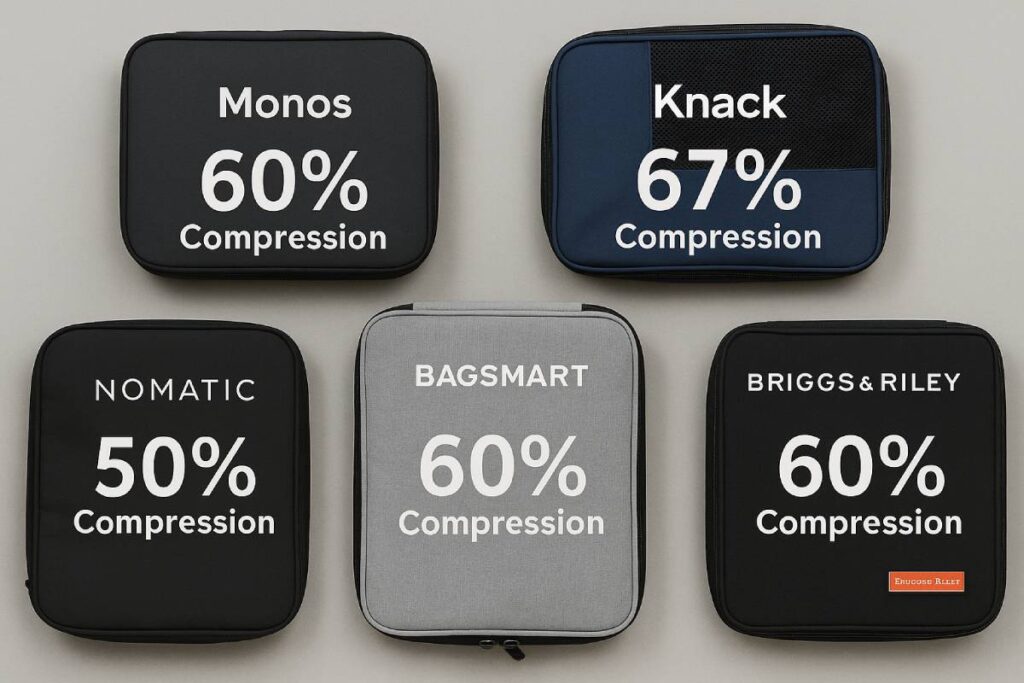
Monos Compressible Packing Cubes
Travel + Leisure’s in-depth test of six Monos cubes showed they compress up to 60%, turning bulky sweaters and jackets into slim, suitcase-ready blocks. Built from tear-resistant nylon twill with anti-catch zippers and antimicrobial interior lining, they balance durability with hygiene—ideal for longer trips.
Reviewers praise the structured cubes for standing upright when empty and folding flat when not in use, making storage a breeze.
| Feature | Details |
|---|---|
| Compression Rate | Up to 60% |
| Material | Nylon twill exterior, antimicrobial interior, mesh panel |
| Set Size | 6 cubes (various dimensions) |
| Pros | Strong zippers, hygienic lining, structured shape |
| Cons | Premium price point |
Nomatic Compression Cubes
According to NOMATIC, their three-cube set uses a zippered system to reduce volume by 50%, shrinking from 5″ depth to just 2.5″. Made of ripstop nylon with see-through mesh, these cubes are both sturdy and lightweight, with a lifetime warranty and easy-grab handles for on-the-go packing. Customer feedback highlights seamless compression and clear visibility of content.
| Feature | Details |
|---|---|
| Compression Rate | ~50% |
| Material | Ripstop nylon, mesh panel |
| Set Size | 3 cubes (small, medium, large) |
| Pros | Lifetime warranty, water-resistant, great value |
| Cons | Fewer size options per set |
BagSmart Compression Cubes
House Beautiful’s hands-on review applauds BagSmart’s durable, three-zipper design (two standard + one compression) for up to 60% space savings, though you may need some elbow grease when the cubes are fully loaded. The zippers never snag, and quick “indent” hacks (pressing the cube’s edge while zipping) dramatically ease compression.
Amazon shoppers report fitting two weeks’ worth of clothes into a single carry-on using these cubes, with over 6,300 five-star ratings highlighting reliability and value.
| Feature | Details |
|---|---|
| Compression Rate | Up to 60% |
| Material | Polyester, reinforced stitching, mesh window |
| Set Size | 6 cubes (3 sizes) + laundry bag & shoe bag |
| Pros | Durable zippers, accessory bags included, budget-friendly |
| Cons | Compression can be stiff when overstuffed |
Briggs & Riley Antibacterial Fabric Cubes
Briggs & Riley’s premium Check-In Cube Set features 2″ expansion/compression via a smooth dual-zipper system, packing more with less space while preventing odors with antibacterial–treated interior fabric.
Constructed from recycled PET polyester (15 bottles per set), each cube comes with sturdy carry handles and sizes perfectly tuned for their check-in bags. Travel experts commend the brand’s lifetime guarantee and seamless integration with Briggs & Riley luggage.
| Feature | Details |
|---|---|
| Compression Depth | 2″ expansion & compression |
| Material | Recycled PET polyester, antibacterial interior |
| Set Size | 3 cubes (small, medium, large) |
| Pros | Odor-resistant fabric, sustainable materials, lifetime warranty |
| Cons | Higher price tier |
Bottom Line:
- For maximum compression and style, Monos cubes top our list at 60% reduction with premium hygiene features.
- For balanced performance and warranty, Nomatic’s 50% savings and lifetime guarantee are hard to beat.
- For budget-minded travelers, BagSmart delivers up to 60% compression plus bonus accessory bags at a wallet-friendly price.
- For eco-conscious packers, Briggs & Riley offers sustainable, antibacterial cubes with guaranteed durability and 2″ of compression.
Choose the set that best aligns with your trip length, luggage type, and organizational priorities—then pack smart, save space, and travel happier!
Beyond Space Saving: Organizational Benefits
Packing cubes aren’t just about squeezing more into your bag—they revolutionize how you organize, access, and even plan your travel wardrobe. By turning loose clothing into neat, category-based pouches, cubes significantly cut down on packing and unpacking time, help you map out daily outfits, and ensure garments stay wrinkle-free and at your fingertips.
Below, we explore two key organizational benefits backed by expert insights and real-world tests.
How Cubes Speed Up Packing/Unpacking and Outfit Planning
Packing cubes not only create extra space but also transform your suitcase into an organized system, speeding up packing and unpacking by eliminating the need to rifle through layers of clothing. By assigning each cube a category—such as tops, bottoms, or accessories—you can seamlessly transition from one location to the next, slashing reload times and reducing travel friction.
Additionally, dedicating a cube per outfit lets you quickly grab your daily look without agonizing over mismatched pieces, as noted in packing-cube how-to guides. According to Wikipedia, packing cubes are designed to compartmentalize clothing, providing structure that simplifies grouping and retrieving outfits on the road.
Real Simple experts also recommend planning outfits and clustering them in packing cubes, reducing decision fatigue, and ensuring each ensemble is ready when you need it.
Keeping Clothes Wrinkle-Free and Items Accessible
Rolling garments inside cubes and tightening them with compression zippers helps prevent wrinkles, as snug storage keeps fabrics from shifting and creasing during transit. When you unzip a cube at your destination, every piece emerges ready-to-wear, saving prep time and maintaining professional, wrinkle-free attire.
Southern Living’s travel editor emphasizes that cubes allow travelers to see their entire wardrobe at a glance, preventing over-packing and keeping essentials within arm’s reach throughout the trip. Conde Nast Traveler suggests assigning a permanent “essentials” cube—packed with chargers and toiletries—to skip last-minute scrambles, demonstrating the versatility of cubes beyond clothing.
By leveraging these organizational benefits—faster packing cycles, outfit-specific cubes, wrinkle prevention, and instant accessibility—you’ll not only save time but also reduce travel stress and stay effortlessly polished wherever you go.
Potential Drawbacks and What to Avoid
Packing cubes are a game-changer for organization and space gains—but they’re not without trade-offs. Below, we’ll look at three key drawbacks you’ll want to consider before committing to a cube set, backed by real-world feedback and expert analysis.
Added Weight and Bulk of Unused Cubes
Even empty, packing cubes add heft and take up room, especially noticeable in minimalist gear setups. In one Reddit thread, a traveler switched to compression bags after realizing their three-cube set bumped their carry-on weight up by 3 lbs, despite identical contents.
Another user held a full cube set in hand and dismissed it as “too heavy and bulky” for backpacking, preferring ultralight dry bags instead. A third commenter noted that some budget cubes weigh more than double other ultralight models, making them a poor fit for weight-sensitive trips.
Overfilling Cubes Leading to Diminishing Returns
Stuffing every cube to the brim can backfire: as you add more pouches, the incremental space you reclaim shrinks. One Reddit “onebag” user warned of a diminishing return with each extra cube, noting that multiple overfilled cubes leave awkward gaps that can’t be molded to your bag’s shape.
Travel + Leisure echoes this, advising travelers to leave a small bit of give—about an inch of zipper slack—so cubes can flex and fit snugly without forcing them open or creating dead space.
Unsubstantiated Marketing Claims to Watch Out For
Not all cube makers play fair on the specs.
- Waterproof vs. water-resistant: Pack Hacker’s long-term test of Arkadia Elfin cubes found they’re merely water-resistant, despite marketing that implies full waterproofing.
- Overblown review counts: A high-profile brand claimed 10,000 five-star reviews, yet a reputable site like Trustpilot showed just 669 verified ratings—an order-of-magnitude mismatch and red flag for savvy shoppers.
- Compression percentages: Be wary of specs that promise “up to 80% compression” without test conditions; most independent tests cap at around 60–67% on medium and large cubes, with smaller doubts on long-term zipper durability.
What to Avoid:
- Heavy, all-purpose sets when you need ultralight gear.
- Overstuffing every cube in pursuit of maximum volume gain.
- Taking marketing claims at face value—always cross-check with unbiased user tests and reviews.
By acknowledging these pitfalls, you can choose the right cube type, pack smarter, and avoid surprises that negate your space-saving goals.
Conclusion
Across rigorous editor tests and real-world traveler feedback, packing cubes offer a compelling mix of space savings and organizational prowess. Travel + Leisure’s five-month evaluation found top compression cubes like Monos can evacuate up to 60% of trapped air, and Knack’s medium cubes compress by 67%, turning bulky layers into neat bricks.
Yet, as Forbes reminds us, their greatest strength lies in rapid outfit organization—no more digging through jumbled clothes to find that one shirt.
While simple rolling techniques only yield about 5–15% space savings, combining rolling with compression cubes bridges the gap between speed and efficiency. For maximum volume reduction, vacuum-seal bags can reclaim up to 75% of space, but they come with wrinkle risks and require extra gear.
Beyond mere compression, cubes streamline packing and unpacking workflows—Southern Living’s editor swears by a dedicated “essentials” cube for instant access to daily must-haves—and help keep garments wrinkle-free by locking them in place during transit.
That said, empty cubes add 2–3 lbs to your load if you’re not careful, and overfilling them can create awkward gaps that undermine overall efficiency. Be wary of overblown marketing—some brands claim to be “waterproof” when, upon closer inspection, they are merely water-resistant.
Ultimately, choose a set that aligns with your travel style: ultralight ripstop nylon for weight-conscious trips (per Wikipedia’s overview of cube materials), structured antimicrobial cubes for longer journeys, or eco-friendly options if sustainability matters.
Top recommendations span Monos (60% compression), Knack Bags (67% medium, 60% large), Nomatic (≈50% space reduction), BagSmart (~60% with accessory bags), and Briggs & Riley (2″ expansion/compression with antibacterial fabric).
With the right cube strategy—pairing rolls with compression, selecting sizes for trip length, and packing smartly in carry-ons vs. checked bags—you’ll master the art of efficient, organized, and stress-free travel. Pack smarter, travel lighter, and let every journey begin with calm and confidence.
FAQs
What’s the difference between regular and compression packing cubes?
Regular cubes organize; compression cubes add a second zipper (or strap) to expel air, reducing volume by 50–67%.
Can rolling clothes match packing-cube savings?
Rolling alone typically saves 5–15% space, but rolling inside a cube before compression can outperform folding methods.
Are vacuum bags better than compression cubes?
Vacuum bags achieve up to 75% reduction but add wrinkle risk, require pumps or heavy gear, and aren’t reusable for delicate fabrics.
How many packing cubes do I need?
For weekend trips, 3–4 cubes suffice; for one- to two-week journeys, 4–6 cubes (small for intimates, medium for tops, large for sweaters).
Will packing cubes add bulk when not in use?
Yes—budget sets can add 2–3 lbs empty. For ultralight travel, consider thin ripstop nylon cubes or skip if weight is critical.

